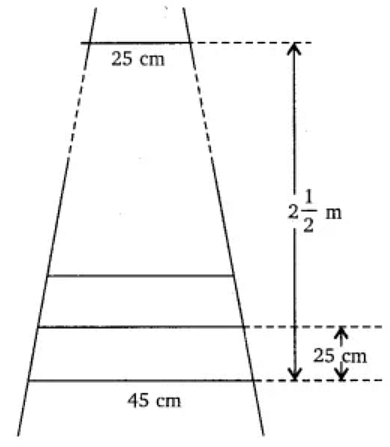Question:
A ladder has rungs 25 cm apart. (see Fig. 5.7). The rungs decrease uniformly in length from 45 cm at the bottom to 25 cm at the top. If the top and the bottom rungs are \(2\frac 12\) m apart, what is the length of the wood required for the rungs?
Fig. 5.7
A ladder has rungs 25 cm apart. (see Fig. 5.7). The rungs decrease uniformly in length from 45 cm at the bottom to 25 cm at the top. If the top and the bottom rungs are \(2\frac 12\) m apart, what is the length of the wood required for the rungs?
Fig. 5.7

Updated On: Jun 15, 2024
Hide Solution
Verified By Collegedunia
Solution and Explanation
It is given that the rungs are 25 cm apart and the top and bottom rungs are \(2\frac 12\) m apart.
∴ Total number of rungs = \(\frac {2\frac 12 \times 100}{25} +1 = \frac {250}{25} + 1 = 11\)
Now, as the lengths of the rungs decrease uniformly, they will be in an A.P.
The length of the wood required for the rungs equals the sum of all the terms of this A.P.
First term, \(a = 45\)
Last term, \(l = 25\) and \(n = 11\)
\(S_n = \frac n2(a+l)\)
\(S_{10} = \frac {11}{2}(45+25)\)
\(S_{10}= \frac {11}{2} (70)\)
\(S_{10}= 385\) cm
Therefore, the length of wood is 385cm.
∴ Total number of rungs = \(\frac {2\frac 12 \times 100}{25} +1 = \frac {250}{25} + 1 = 11\)
Now, as the lengths of the rungs decrease uniformly, they will be in an A.P.
The length of the wood required for the rungs equals the sum of all the terms of this A.P.
First term, \(a = 45\)
Last term, \(l = 25\) and \(n = 11\)
\(S_n = \frac n2(a+l)\)
\(S_{10} = \frac {11}{2}(45+25)\)
\(S_{10}= \frac {11}{2} (70)\)
\(S_{10}= 385\) cm
Therefore, the length of wood is 385cm.
Was this answer helpful?
2
1
Top Questions on Sum of First n Terms of an AP
- Let the first term of a series be \( T_1 = 6 \) and its \( r^\text{th} \) term \( T_r = 3T_{r-1} + 6^r \), \( r = 2, 3, \dots, n \). If the sum of the first \( n \) terms of this series is \[ \frac{1}{5} \left(n^2 - 12n + 39\right) \left(4 \cdot 6^n - 5 \cdot 3^n + 1\right), \] then \( n \) is equal to ______.
- JEE Main - 2024
- Mathematics
- Sum of First n Terms of an AP
- \[\lim_{n \to \infty} \frac{(1^2 - 1)(n-1) + (2^2 - 2)(n-2) + \ldots + ((n-1)^2 - (n-1))}{(1^3 + 2^3 + \ldots + n^3) - (1^2 + 2^2 + \ldots + n^2)}\]is equal to:
- JEE Main - 2024
- Mathematics
- Sum of First n Terms of an AP
- Let \( S_n \) denote the sum of the first \( n \) terms of an arithmetic progression. If \( S_{20} = 790 \) and \( S_{10} = 145 \), then \( S_{15} - S_5 \) is:
- JEE Main - 2024
- Mathematics
- Sum of First n Terms of an AP
- If \(S_n=3+7+11....\) upto \(n\) terms and \(40<\frac {6}{n(n+1)}\displaystyle\sum_{k=1}^n S_k<45\). Then \(n\) is
- JEE Main - 2024
- Mathematics
- Sum of First n Terms of an AP
- Let \(a_1,a_2,a_3\), ..., an, be in A. P. and \(S_n\) denotes the sum of first \(n\) terms of this A. P. is \(S_{10}\) =\(390, \frac{a_{10}}{a_{50}} =\frac{15}{7}\), then \(S_{15} -S_5 =\) _________.
- JEE Main - 2024
- Mathematics
- Sum of First n Terms of an AP
View More Questions
Questions Asked in CBSE X exam
- Bholi’s real name is Sulekha. We are told this right at the beginning. But only in the last but one paragraph of the story is Bholi called Sulekha again. Why do you think she is called Sulekha at that point in the story?
- CBSE X
- Bholi
- Explain the following terms with one example each.
(a) Corrosion
(b) Rancidity- CBSE X
- Effects Of Oxidation Reactions In Everyday Life
- Show how you would connect three resistors, each of resistance 6 Ω, so that the combination has a resistance of
- 9 Ω
- 4 Ω
- CBSE X
- Resistance Of A System Of Resistors
- Why are books referred to as a man’s best companion? Which is your favourite book and why? Write a paragraph about that book.
- CBSE X
- The Book That Saved The Earth
- Does Bholi enjoy her first day at school?
- CBSE X
- Bholi
View More Questions



